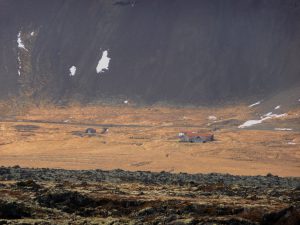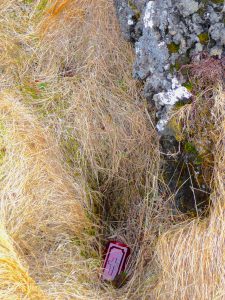

Björn Pétursson, later known as Axlar-Björn, was sentenced to death by limbs being hammered and chopped to pieces in 1596 at Laugarbrekka, near Hellnar on the Snaefellsnes peninsula. What kind of wicked crime deserved this punishment. Well, it’s a wild and true tale.
When traveling I like to talk to people and find out interesting stories, past and present. While staying at the Hotel Búdir in Snaefellsness, one of the staff filled me in on Axlar-Björn, whose farm property is visible across the lava fields and some hotel windows.
At one time, the now 10-person village of Búdir was a fishing village and trade center with small farms dotted on the sides of volcanic mountains. One was Farm Öxl on the shoulder of such a mountain very close to Búdir. Along and within sight of the main trade road Axlar-Björn’s farm was often host to travelers on the way from one town to the next. And while travelers entered the farmhouse for the night, many never left.
Björn would rob his victims, estimated to be between 9 and 18 people, of their clothing, money and horses. After axing them to death, he deposed of their bodies in cowshed manure pits, in the holes of the lava fields, or immerse them in a small lake, Ígultjörn, on his land below the Axlarhólar hills. He plied his vicious trade over many years becoming rich before being unmasked. Thus Björn Pétursson enters history as Axlar-Björn.
The tale has it that Björn may have first come under suspicion when one of his victim’s brothers came searching and recognized the shirt Björn was wearing. He was questioned but not taken in. The capture may have came when two siblings traveling together stayed at the farm. One was killed, but the other was able to escape and inform the local police. Another version is that a mother escaped while Björn killed her two children.
Apparently the acorn doesn’t fall far from the tree. Björn’s wife, Pórdis Ólafsdottir, was not sentenced to death as an accessory because she was pregnant. That son, Sveinn Skotti Björnsson, was hanged in 1648 after an attempted rape of a housewife. An older son, Gísli, was also hung for serious, but unknown crimes, in Dyrhólaey.
It’s no surprise that Icelanders are still intrigued by this wild history. The Book of Icelanders, Íslendingabók, is still sometimes searched by families to detect any ancestry to Axlar-Björn, Pórdis or the two bad seed sons. In 2012, a eponymously named play premiered in Reykjavik.
Want to visit Alxar-Bjóns remains? There is a sole surviving cairn identified by a simple sign stating “Dreplaklludys” on Hellnavegar road that takes you into the village of Hellner. Supposedly at his execution Axlar-Björn’s various dismembered parts were interned in three different locations to prevent any revenging hauntings. The other two cairns were destroyed in roadwork projects, which is why the single remaining cairn has a protected status preserving this bit of homicidal history.
I asked the gal who gave me the Reykjavik Haunted Walk tours if Búdir and the surrounding lava fields are haunted. “What do you think?” was all she replied.
The photo is the farmland where Axlar-Björn lived and carried out his crimes. The farm house and buildings are not.


